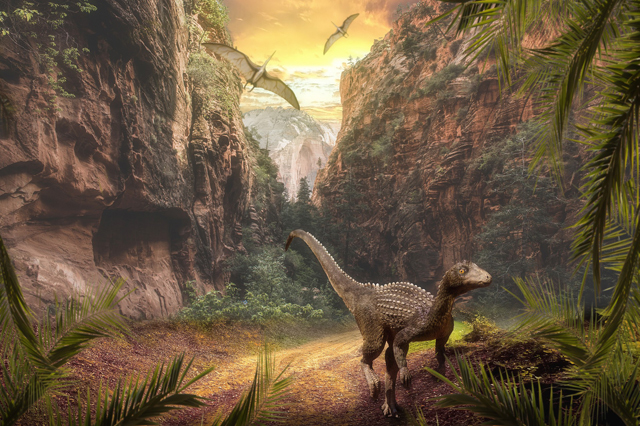Climate change was the main factor in the rise of dinosaurs during the Late Triassic and Early Jurassic periods, rather than competition with other species. A new study found that global climate changes caused by the Triassic-Jurassic mass extinction event, which led to the extinction of many large land-dwelling animals such as aetosaurs, actually helped the earliest dinosaurs thrive.
To be more specific, sauropod-like dinosaurs, which eventually evolved into giant herbivorous species such as Diplodocus and Brachiosaurus during the Jurassic period, were able to prosper and spread to new areas as the earth warmed up following the mass extinction event that occurred 201 million years ago. This research was recently published in the journal Current Biology by a group of paleontologists from universities in the UK, Germany, and Brazil, led by the Universities of Birmingham and Bristol.
The research team used computer models to analyze prehistoric global climate conditions, such as temperature and rainfall and compared this data to the locations of different dinosaur species, taken from sources such as the Paleobiology Database. They found that sauropod dinosaurs and sauropod-like animals, characterized by their long tails and necks and small heads, were the most successful during this tumultuous period of evolution.
Thriving in Climate Conditions
Dr. Emma Dunne, a paleontology lecturer at Friedrich-Alexander University Erlangen-Nürnberg who researched while at the University of Birmingham, said that the data suggests that it was changes in climate conditions rather than competition with other large vertebrates that limited dinosaur diversity. However, once these conditions changed at the Triassic-Jurassic boundary, dinosaurs were able to thrive.
The shift in the climatic conditions inhabited by non-sauropodomorph dinosaurs from the Late Triassic to the Early Jurassic likely reflects global changes in climate patterns during this period and possibly also a general northward movement of northern hemisphere fossil record sampling during the same interval. This shift occurs despite there being fewer well-sampled fossil assemblages in the Early Jurassic compared to the Late Triassic, which might be expected to make climatic regimes more distinct if the signal was solely driven by spatial variation in sampling.
The lack of support for a shift in the evolutionary regime for sauropodomorphs suggests that overall climatic niches for this group remained relatively similar, despite changing global climate distributions, and that the increases in the paleogeographic range, abundance, and phenotypic diversity of sauropodomorphs primarily reflect an expansion of favorable climatic conditions for this group during the Early Jurassic. In terms of classic hypotheses about the early evolution of dinosaurs, these results are consistent with the idea that dinosaurs expanded opportunistically in response to changing environmental conditions.

Ecological changes following intense volcanic activity during the Carnian Pluvial Episode 230 million years ago paved the way for dinosaurs to become the dominant terrestrial fauna.
ALSO READ: Wooly Mammoths Wiped Out by Climate Change, Humans Not To Blame
Supporting Sauropodomorphs
During the Late Triassic period, sauropodomorphs were not found in lower latitudes in North America and northern Africa, despite extensive sampling in key regions of North America in particular. Studies of the paleoenvironment have shown that lower latitudinal regions during the Late Triassic experienced significant environmental fluctuations, characterized by recurring periods of extreme aridity and humidity and exacerbated by frequent wildfire activity and droughts.
There are several hypotheses for the absence of sauropodomorphs from these regions, including the idea that they were subjected to unstable environmental conditions that may have limited food resources for large herbivores. A recent study that used biophysical modeling suggested that heat stress may have been a limiting factor for the early distribution of sauropodomorphs, while others have concluded that the northward dispersal of sauropodomorphs from Gondwana during the Late Triassic was likely facilitated by the lowering of climatic barriers in low-latitude regions.
The findings suggest that the paleogeographic restriction of Late Triassic sauropodomorphs to mid and high latitudes reflects their occupation of more limited climatic conditions compared to other Late Triassic tetrapods, including theropod dinosaurs. Late Triassic sauropodomorphs lived within a relatively narrow range of climatic conditions, characterized in particular by relatively cool mean annual temperatures. These results support the hypothesis that low-latitude climatic conditions acted as a barrier to the distribution of sauropodomorphs during the Late Triassic.
RELATED ARTICLE: Dinosaur Death Theories: Did Carbon Dioxide from Volcanic Major Eruptions Killed Them?
Check out more news and information on Dinosaurs and Extinction in Science Times.




![Earth's Quasi-Moon Kamo‘oalewa Could Originate From Lunar Surface Not Asteroid Belt [Study]](https://1721181113.rsc.cdn77.org/data/thumbs/full/53275/89/56/50/40/earths-quasi-moon-kamo-oalewa-could-originate-from-lunar-surface-not-asteroid-belt-study.png)









